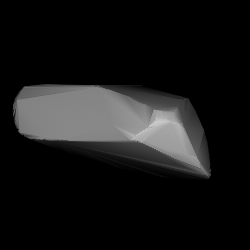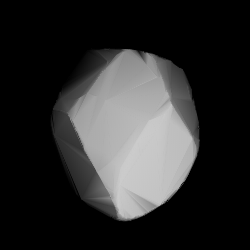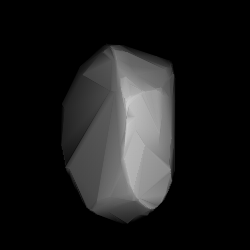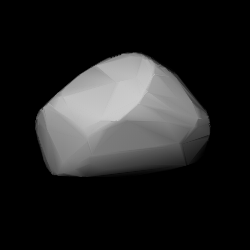Related Research Articles
1145 Robelmonte, provisional designation 1929 CC, is a Vestian asteroid from the inner regions of the asteroid belt, approximately 23 kilometers in diameter.

1652 Hergé, provisional designation 1953 PA, is a stony Florian asteroid from the inner regions of the asteroid belt, approximately 9 kilometers in diameter. It was discovered on 9 August 1953, by Belgian astronomer Sylvain Arend at the Royal Observatory of Belgium in Uccle, Belgium. It was later named after Belgian cartoonist Hergé.

1286 Banachiewicza is an elongated Eos asteroid from the outer regions of the asteroid belt. It was discovered on 25 August 1933, by Belgian astronomer Sylvain Arend at the Royal Observatory of Belgium in Uccle. The stony S-type asteroid has a rotation period of 8.6 hours and measures approximately 21 kilometers in diameter. It was named after Polish astronomer Tadeusz Banachiewicz.
1570 Brunonia, provisional designation 1948 TX, is a stony asteroid of the Koronis family from the outer regions of the asteroid belt, approximately 12 kilometers in diameter. It was discovered on 9 October 1948, by Belgian astronomer Sylvain Arend at the Royal Observatory of Belgium in Uccle. The S-type asteroid is likely elongated and has a longer-than-average rotation period of more than 48 hours. It was named for Brown University in Rhode Island, United States.

1576 Fabiola, provisional designation 1948 SA, is a Themistian asteroid from the outer regions of the asteroid belt, approximately 27 kilometers in diameter. It was discovered on 30 September 1948, by Belgian astronomer Sylvain Arend at the Royal Observatory of Belgium in Uccle. The asteroid was named after Queen Fabiola of Belgium.
1184 Gaea, provisional designation 1926 RE, is an Aerian asteroid from the central regions of the asteroid belt, approximately 20 kilometers in diameter. It was discovered on 5 September 1926, by astronomer Karl Reinmuth at the Heidelberg-Königstuhl State Observatory in southwest Germany. The asteroid was named after the goddess of Earth, Gaea (Gaia), from Greek mythology.
1199 Geldonia, provisional designation 1931 RF, is an Eoan asteroid from the outer regions of the asteroid belt, approximately 32 kilometers in diameter. It was discovered on 14 September 1931, by Belgian astronomer Eugène Delporte at the Royal Observatory of Belgium in Uccle. The asteroid was named after the Belgian town of Jodoigne.
1532 Inari, provisional designation 1938 SM, is a stony Eoan asteroid from the outer regions of the asteroid belt, approximately 28 kilometers in diameter. Discovered by Yrjö Väisälä at Turku Observatory in 1938, it was later named for Lake Inari in northern Finland.

1281 Jeanne is a dark asteroid from the background population of the intermediate asteroid belt. It was discovered on 25 August 1933, by astronomer Sylvain Arend at the Royal Observatory of Belgium in Uccle, who named it after his daughter, Jeanne. The likely P-type asteroid has a rotation period of 15.2 hours and measures approximately 22 kilometers in diameter.
1755 Lorbach, provisional designation 1936 VD, is a stony Eoan asteroid from the outer region of the asteroid belt, approximately 25 kilometers in diameter.
1410 Margret, provisional designation 1937 AL, is an Eoan asteroid from the outer regions of the asteroid belt, approximately 21 kilometers in diameter. It was discovered on 8 January 1937, by astronomer Karl Reinmuth at the Heidelberg Observatory in southwest Germany. The asteroid was named after Margret Braun, wife of the Heidelberg astronomer Heinrich Vogt.
1247 Memoria, provisional designation 1932 QA, is a dark Themistian asteroid from the outer regions of the asteroid belt, approximately 37 kilometers in diameter. It was discovered by Marguerite Laugier at Uccle Observatory in 1932, who later named it Memoria in memory of her pleasant stay at the discovering observatory.

1291 Phryne, provisional designation 1933 RA, is an Eoan asteroid from the outer regions of the asteroid belt, approximately 27 kilometers in diameter. It was discovered on 15 September 1933, by Belgian astronomer Eugène Delporte at the Royal Observatory of Belgium in Uccle. The asteroid was named after the ancient Greek courtesan Phryne.
1711 Sandrine, provisional designation 1935 BB, is a stony Eoan asteroid from the outer region of the asteroid belt, approximately 23 kilometers in diameter.
1262 Sniadeckia, provisional designation 1933 FE, is a carbonaceous background asteroid from the asteroid belt's outer regions, approximately 54 kilometers in diameter. It was discovered on 23 March 1933, by Belgian astronomer Sylvain Arend at the Royal Observatory of Belgium in Uccle. The asteroid was named for Polish astronomer Jan Śniadecki. It has a notably low eccentricity of only 0.005.

2111 Tselina is a stony Eos asteroid from the outer regions of the asteroid belt. It was discovered on 13 June 1969, by Soviet astronomer Tamara Smirnova at Crimean Astrophysical Observatory in Nauchnij, on the Crimean peninsula. The S-type asteroid has a rotation period of 6.6 hours and measures approximately 23 kilometers in diameter. It was later named after the Soviet Virgin Lands Campaign.

1276 Ucclia is a carbonaceous Alauda asteroid from the outer region of the asteroid belt, approximately 31 kilometers in diameter. It was discovered on 24 January 1933 by Belgian astronomer Eugène Delporte at the Royal Observatory of Belgium in Uccle. Two nights later, the body was independently discovered by Richard Schorr at Bergedorf Observatory in Hamburg, Germany. It was named for the Belgium city of Uccle and its discovering observatory.
1887 Virton, provisional designation 1950 TD, is a stony Eoan asteroid from the outer region of the asteroid belt, approximately 21 kilometers in diameter. It was discovered by Belgian astronomer Sylvain Arend at the Royal Observatory of Belgium in Uccle on 5 October 1950, and named after the Belgian town of Virton.

5357 Sekiguchi is an Eos asteroid from the outer region of the asteroid belt, approximately 15 kilometers in diameter. It was discovered on 2 March 1992, by Japanese amateur astronomers Tetsuya Fujii and Kazuro Watanabe at the Kitami Observatory in eastern Hokkaidō, Japan. The asteroid was later named after Japanese astronomer Tomohiko Sekiguch.
7449 Döllen, provisional designation 1949 QL, is a stony Florian asteroid from the inner regions of the asteroid belt, approximately 3.5 kilometers in diameter. It was discovered on 21 August 1949, by German astronomer Karl Reinmuth at the Heidelberg Observatory in southwest Germany. The likely S-type asteroid has a rotation period of 10 hours. It was named after German astronomer Wilhelm Döllen.
References
- 1 2 3 4 5 6 "JPL Small-Body Database Browser: 1287 Lorcia (1933 QL)" (2016-12-13 last obs.). Jet Propulsion Laboratory. Archived from the original on 18 September 2020. Retrieved 19 September 2017.
- 1 2 3 Schmadel, Lutz D. (2007). "(1287) Lorcia". Dictionary of Minor Planet Names. Springer Berlin Heidelberg. p. 106. doi:10.1007/978-3-540-29925-7_1288. ISBN 978-3-540-00238-3.
- 1 2 "Asteroid 1287 Lorcia – Nesvorny HCM Asteroid Families V3.0". Small Bodies Data Ferret. Retrieved 26 October 2019.
- 1 2 3 Masiero, Joseph R.; Grav, T.; Mainzer, A. K.; Nugent, C. R.; Bauer, J. M.; Stevenson, R.; et al. (August 2014). "Main-belt Asteroids with WISE/NEOWISE: Near-infrared Albedos". The Astrophysical Journal. 791 (2): 11. arXiv: 1406.6645 . Bibcode:2014ApJ...791..121M. doi:10.1088/0004-637X/791/2/121 . Retrieved 19 September 2017.
- 1 2 "1287 Lorcia (1933 QL)". Minor Planet Center. Retrieved 19 September 2017.
- ↑ Nesvorný, D.; Broz, M.; Carruba, V. (December 2014). "Identification and Dynamical Properties of Asteroid Families". Asteroids IV. pp. 297–321. arXiv: 1502.01628 . Bibcode:2015aste.book..297N. doi:10.2458/azu_uapress_9780816532131-ch016. ISBN 9780816532131.
- ↑ "LCDB Data for (1287) Lorcia". Asteroid Lightcurve Database (LCDB). Retrieved 19 September 2017.